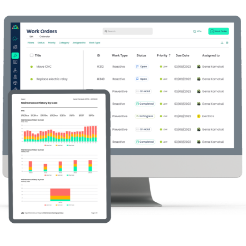
The Power of Checklists in Maintenance Management: Lessons from The Checklist Manifesto
The implementation of simple, yet powerfully effective, checklists has repeatedly demonstrated their value across diverse high-stakes environments. A compelling example comes from a hospital in Michigan, which, a few years ago, introduced a straightforward five-step checklist for central line insertions. The impact of this seemingly minor change was profound and immediate: infection rates plummeted dramatically, countless lives were saved, and healthcare costs were significantly reduced. What made this achievement even more remarkable was that the checklist wasn't designed to supersede the existing medical skills of the practitioners; rather, its sole purpose was to ensure that fundamental, critical steps were consistently remembered and executed, even when professionals were operating under immense pressure or facing distractions.
This core insight is masterfully explored in Atul Gawande’s seminal work, The Checklist Manifesto. Gawande argues persuasively that even highly experienced experts, across various fields, are prone to making errors when tasks become inherently complex, or when they are subjected to high levels of stress, fatigue, or interruption. The human brain, while incredibly capable, has its limitations, and in environments where precision and consistency are paramount, a structured, external aid can be invaluable. This principle isn't new or exclusive to medicine. Pilots, for instance, have long relied on rigorous pre-flight checklists to systematically review every essential system and procedure before takeoff. Similarly, surgeons routinely depend on intraoperative checklists to ensure the correct patient, procedure, and site, as well as to mitigate other common risks during surgery.
Maintenance management teams, operating in equally complex and often high-pressure industrial environments, can and should continue to build upon this proven principle. By integrating well-designed checklists into their routines, they can significantly reduce errors, improve efficiency, enhance safety, and ultimately extend the lifespan and reliability of critical assets and systems. The power of the checklist lies in its ability to standardize processes, prevent critical omissions, and provide a reliable safety net for even the most seasoned professionals.

The Checklist Manifesto Book
Published in 2009, Atul Gawande’s The Checklist Manifesto: How to Get Things Right explores the idea that in a world of increasing complexity, simple checklists can save lives and prevent costly mistakes. The book argues that checklists have helped humankind progress in the right direction, not just by improving lives, but by deepening the body of knowledge. Drawing on real-world examples from medicine, aviation, and construction, Gawande demonstrates how even highly trained professionals can benefit from structured reminders. The book argues that checklists are not about limiting creativity and autonomy—they are about ensuring consistency, discipline, and reliability in critical tasks. This framework translates well beyond hospitals and airplanes, offering lessons for any industry where human error has consequences—including maintenance management.
Why Maintenance Teams Need Checklists?
In maintenance operations, minor oversights can lead to major failures. For example:
- A technician skips a lubrication procedure on a preventive maintenance task for a conveyor belt, and later a bearing fails.
- Safety precautions on electrical work are often bypassed when a job is deemed “just routine.”
- Inspection steps are forgotten while rushing to get a production line running again.
These all represent real-life maintenance examples. We are all human after all, and people make mistakes. Stress, fatigue, and shift work can often affect human temperament, negatively impacting performance. Checklists are essential tools that enhance maintenance worker performance. They provide a vital framework, helping individuals overcome the negative impacts of stress, fatigue, and shift work, which can often affect temperament and lead to mistakes.
Beyond acting as safeguards, checklists facilitate continuous improvement. The data generated from completed checklists allows managers to identify trends, refine preventive maintenance tasks, and strengthen reliability programs over time.
It's important to remember that checklists complement, rather than replace, expertise. Their primary function is to ensure critical steps are never missed, regardless of task frequency or familiarity. For maintenance, the benefits include:
- Consistency — Everyone follows the same carefully designed steps.
- Accountability — Tasks are logged, audited, and traceable.
- Safety — The “must-do” safety items are forced into the workflow.
- Efficiency — Less mental burden on technicians, more time on execution.
Dr Gawande’s phrasing applies perfectly: checklists “remind us of the minimum necessary steps” and “make them explicit.”
Modernizing Checklists with CMMS and AI
In the past (and even now in some instances), checklists were printed on paper and carried around on clipboards, and later filed away. Later, Excel and spreadsheets replaced paper, but the same challenges remained and, in some cases, even compounded. Errors in transcription, lost forms, or ambiguity were common. Technology in the form of CMMS software has helped alleviate those problems.
CMMS Checklists
Today’s CMMS (Computerized Maintenance Management Software) transforms maintenance checklists into living, actionable components of the maintenance workflow.
With a modern CMMS, maintenance professionals can:
Embed checklists inside PM (Preventive Maintenance) tasks and work orders.
- Standardize inspection protocols across multiple sites.
- Automatically record time, signatures, notes, and photos.
- Trigger follow-up or corrective work orders based on the outcomes of the checklist.
- Generate compliance reports or analytics from completed checklist data.
For example, a technician inspecting an HVAC chiller could access the checklist via a mobile app, check off each step, capture an image of a refrigerant leak, and the CMMS software can automatically generate a follow-up task. What used to be paper now becomes structured, auditable data.
Generative AI CMMS
As CMMS platforms evolve, artificial intelligence (AI) is enhancing and optimizing the traditional checklist. Instead of static task lists, AI-powered CMMS can analyze asset history, sensor data, and technician notes to generate dynamic Gen AI checklists tailored to each situation. For example, if vibration data indicates a potential bearing failure, the CMMS may automatically adjust the inspection checklist to prioritize lubrication and alignment. Over time, AI learns from recurring failures, technician input, and evolving checklists, enabling maintenance teams to transition from reactive compliance to predictive maintenance.
Maintenance Checklists Work - Real-life Case Studies
Here are a couple of cases where maintenance organizations leveraged checklists with CMMS software in real operations:
Clearwater Pulp & Paper (British Columbia)
At Clearwater Pulp & Paper, an aging workforce and a wave of retirements left the company with fragmented maintenance knowledge. They turned to a CMMS to:
- Capture decades of repair history in a searchable historical database.
- Automate monthly safety audits, which previously required days of manual effort.
- Identify a failing heat exchanger early—avoiding what could have been a multimillion-dollar production outage.
In effect, the automated audits were checklists structured within the CMMS; mistakes or lapses no longer went undetected in paper forms.
Multi-site Example (United States)
A multi-site operation using Fiix CMMS embedded checklists into their PM program across 25 facilities. Within a year, their results were eye-catching: 83% asset reliability, 99.8% equipment availability, and 86% PM completion rate—enviable stats, in the context of maintenance management.
They also introduced a unifying concept called “The Power of One” — one consistent 12-week cycle, standardized across all sites. The embedded checklists (and consistent task structure) made work comparable across locations and easier to monitor.
Checklists as Enablers, Not Limitations
For maintenance technicians, it’s only natural to wonder if checklists imply a lack of trust in skill or experience. In reality, the opposite is true. Checklists don’t question a technician’s expertise—they reinforce it. By optimizing the mental load of remembering every small detail, checklists free technicians to focus on applying their knowledge where it matters most. The checklist creates a shared standard that elevates the entire maintenance process, ensuring that individual skill contributes to collective reliability and organizational goals.
Checklists also play a key role in training and onboarding. For newer technicians, they act as a learning aid, guiding them through complex tasks step by step. For seasoned professionals, they help capture and pass along tribal knowledge. This way, checklists serve as both a safety net and a bridge between generations of maintenance workers.
Best Practices for Implementing Checklists into the Maintenance Workflow
If this article encourages you to rethink your maintenance checklists, or just get started with it, here are some pointers.
Design your checklists with discipline and user feedback
Not all checklists are helpful. The ones that work best are short, targeted, and practical. Keep them straightforward, actionable, and focused on safety-critical or failure-prone areas. Think of them as guardrails, not encyclopedias. Checklist design is critical for successful implementation and outcomes.
Develop a process to continuously collect feedback on the checklists from maintenance technicians and users. This process will ensure checklist adoption. Technicians are also advised to be involved in the checklist development process.
Link checklists to CMMS workflows
Embed them inside PMs and work orders within the CMMS, so that they become part of the job, not an afterthought. With mobile access, technicians can follow the steps directly at the asset. This CMMS integration reduces paperwork, improves accuracy, and ensures that checklists are always available in real-time.
Use outcome-based triggers
The real power of digital checklists lies in their interaction with the broader CMMS. If a checklist identifies a fault (e.g., a vibration reading outside the range), the system can automatically generate a corrective order. This creates a seamless loop where inspections don’t just document problems—they initiate solutions. Identifying outcomes and the corresponding triggers becomes a vital exercise in the maintenance management process.
Track and audit
Completed checklists create a treasure trove of data. Over time, this information highlights recurring issues, technician workload, and even potential skill gaps. Use these insights for compliance reports (OSHA), performance benchmarking, or continuous improvement projects. A well-audited checklist system demonstrates accountability and readiness for external audits.
Standardized checklist across sites
This is a must. Whether you manage one plant or dozens, a unified checklist framework creates consistency. Standardization helps benchmark performance, compare failure trends, and ensure that best practices are shared across the organization. It also makes onboarding easier for technicians who may move between sites.
When checklists become digital, integrated, dynamic, and data-driven, they no longer feel like “extra paperwork.” They become the backbone of a resilient maintenance program—one that combines human expertise with process discipline to achieve reliability on a large scale.
An Enduring Maintenance Culture
Just as pilots trust their pre-flight lists to prevent disasters and surgeons rely on intraoperative checklists to save lives, maintenance teams can—and should—trust well-designed checklists. Far from doubting technician expertise, checklists highlight it by ensuring skill is applied consistently and effectively. When paired with a capable CMMS, they transform from static forms into powerful tools: enforcing discipline, capturing intelligence, ensuring accountability, and underpinning reliability.
For technicians, this means a lighter mental burden, fewer preventable errors, and more time to do what they do best—solve problems and keep operations running smoothly. For organizations, it means safer workplaces, reduced downtime, and measurable progress toward maintenance goals. Ultimately, the checklist is not a crutch—it’s a catalyst for excellence. And when embraced across an organization, it fosters a culture of reliability, where consistency and accountability become the norm rather than the exception.
TABLE OF CONTENTS
Keep Reading
Tax season is the time of year that often sends a ripple of anxiety through many of us. The ...
11 Nov 2025
Selecting a Computerized Maintenance Management System (CMMS) can, at first glance, be an ...
4 Nov 2025
In healthcare facilities, equipment uptime involves more than achieving operational ...
31 Oct 2025
Companies are subject to economic ups and downs, also known as economic volatility. Today, ...
30 Oct 2025
Maintenance challenges are a constant struggle, with unplanned downtime costing manufacturers ...
27 Oct 2025
Last winter, a maintenance technician at a U.S. paper mill ignored a predictive alert that ...
10 Oct 2025
Many organizations proudly say they “have a CMMS,” but ownership alone doesn’t equal ...
9 Oct 2025
Every maintenance team is under pressure to do more with less. Unplanned downtime is often ...
7 Oct 2025
In manufacturing, every second counts. When production stops, whether due to scheduled ...
2 Oct 2025
The increasing cost of maintenance, lack of accountability, and siloed systems leave many ...
30 Sep 2025
Preventive maintenance is one of those things maintenance teams know they need to do, but it ...
26 Sep 2025
Public services are essential to daily life. The provision of safe roads, functional transit, ...
25 Sep 2025
For most manufacturing facilities, a major focus of their maintenance teams revolves around ...
24 Sep 2025
Have you ever tried explaining to the CEO why the production line has been down for hours ...
18 Sep 2025
Over the past few decades, the hotel industry has undergone a dramatic transformation. ...
16 Sep 2025
Profitability is at the top of the list for manufacturing organizations when conversations ...
12 Sep 2025
Lean manufacturing is a goal that organizations strive for in their quest for operational ...
11 Sep 2025
In many organizations, the primary focus of maintenance work is on completing work orders, ...
9 Sep 2025
Word order backlogs are a reality that all maintenance and facilities management teams face. ...
5 Sep 2025
The critical nature of medical equipment has made maintenance management in healthcare ...
4 Sep 2025






